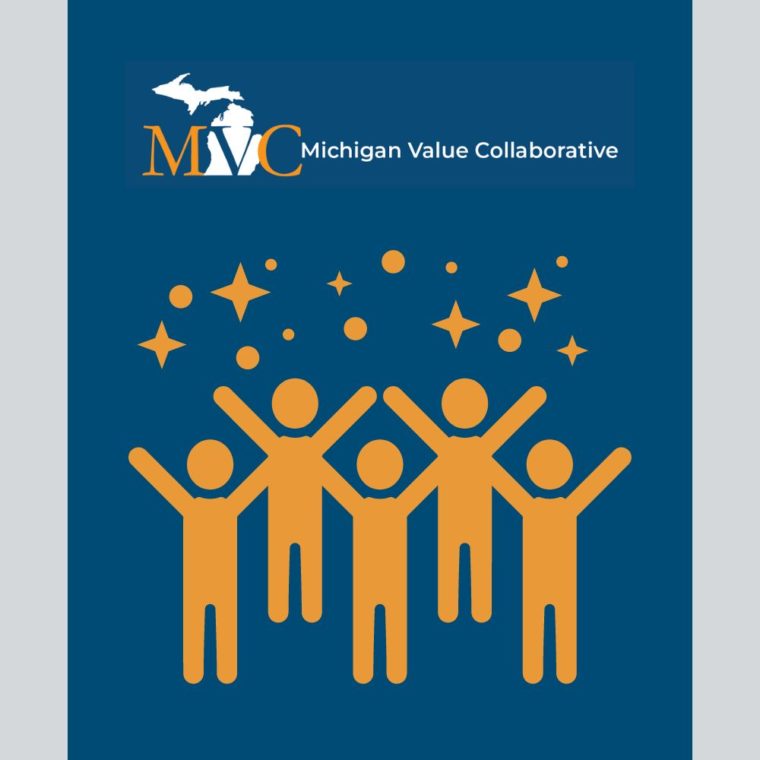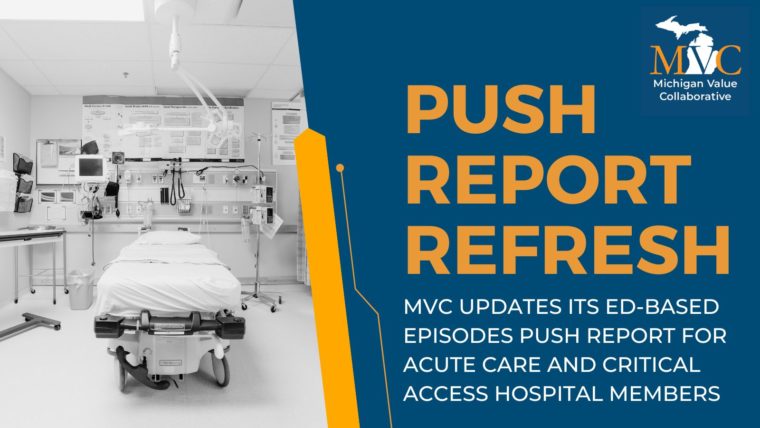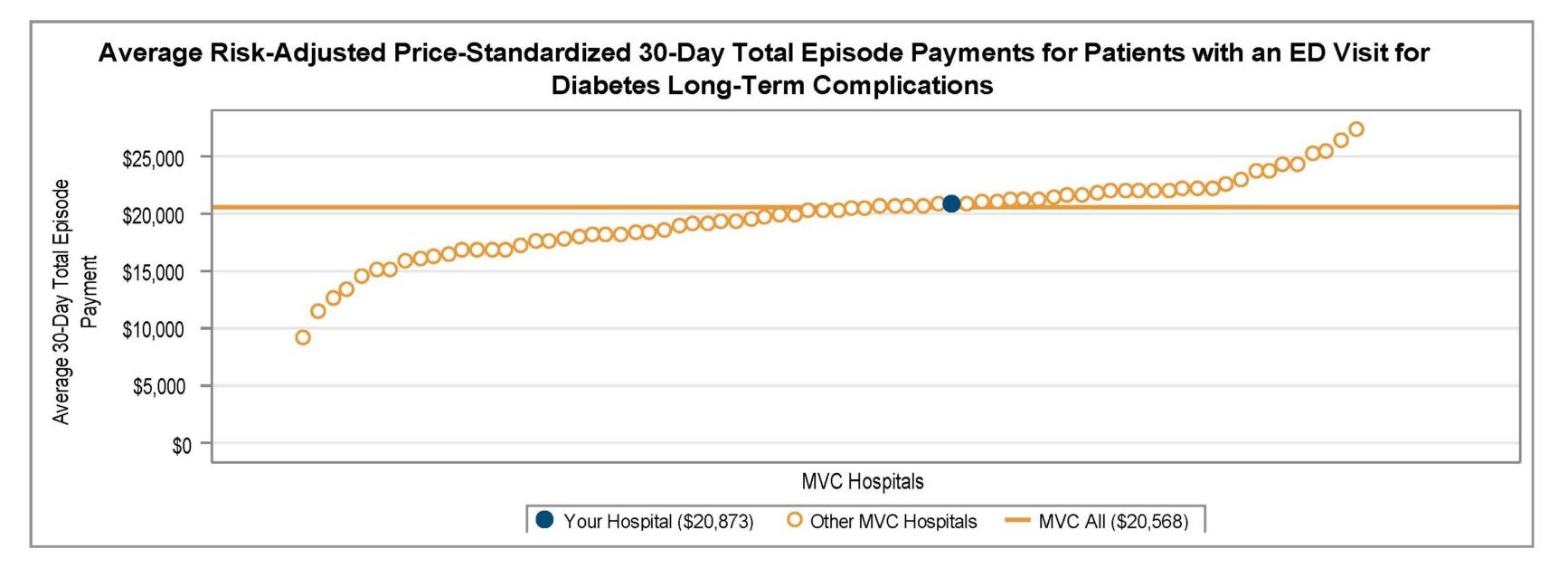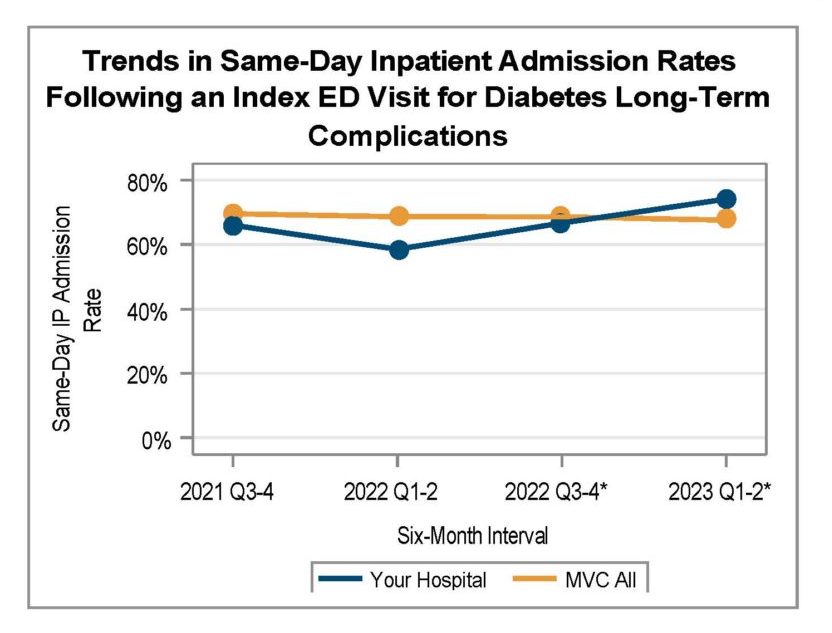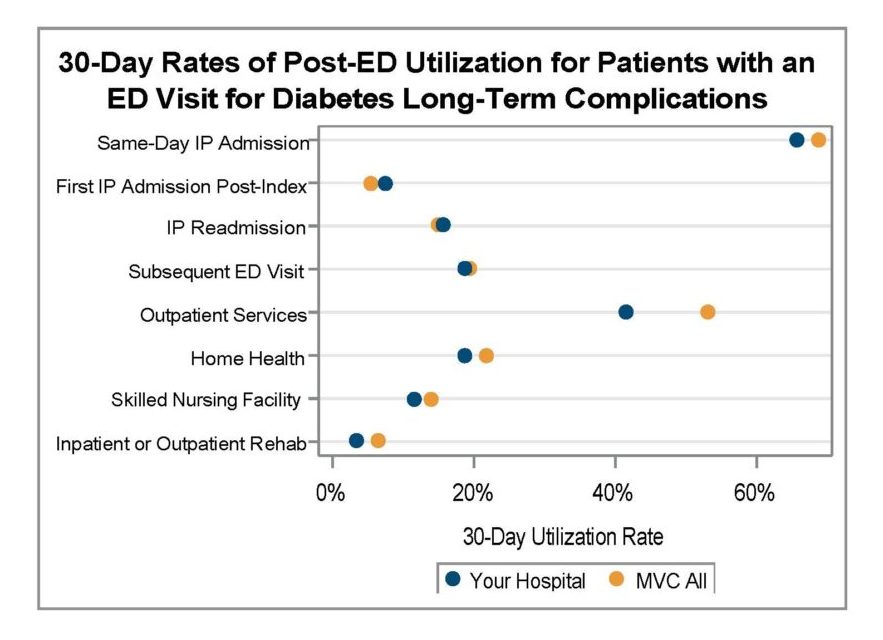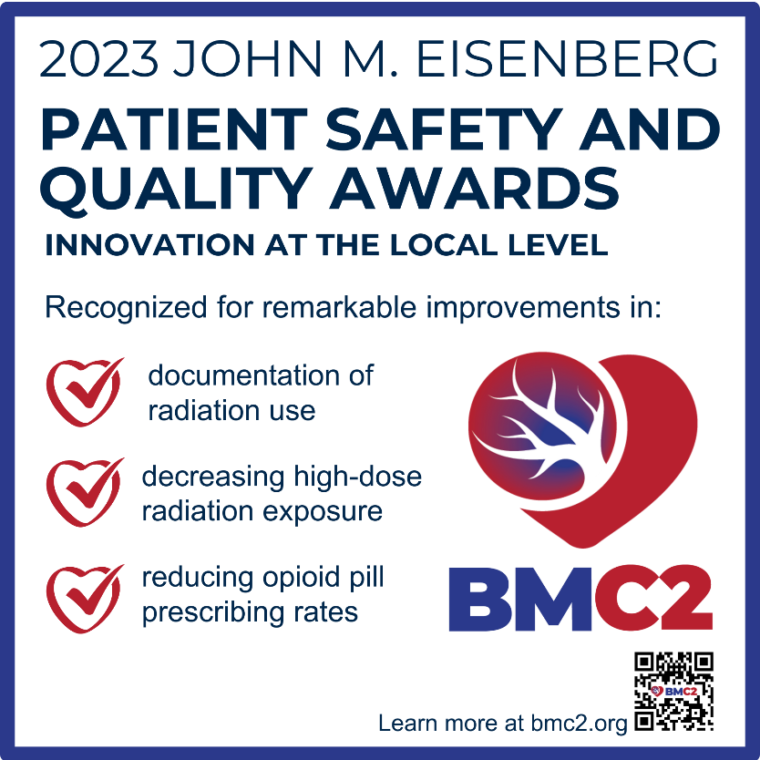MVC Component of the BCBSM P4P Program: PY23 in Review
This month the Michigan Value Collaborative (MVC) Coordinating Center distributed the final scorecards for Program Year (PY) 2023 of the MVC Component of the Blue Cross Blue Shield of Michigan (BCBSM) Pay-for-Performance (P4P) Program. The 2023 program year was the second year of a two-year cycle for which hospitals were evaluated using MVC data. Hospitals were scored on two conditions that they selected from seven options: chronic obstructive pulmonary disease (COPD), colectomy, congestive heart failure (CHF), coronary artery bypass graft (CABG), joint replacement, pneumonia, and spine surgery. Figure one shows the frequency of hospital condition selections for the two-year program cycle. Joint replacement was the most commonly selected condition, and colectomy was selected the least.
The MVC Component of the BCBSM P4P Program evaluates each participating hospital’s risk-adjusted, price-standardized, average 30-day episode payments for their two selected conditions through two methods. Hospitals can earn points by reducing their payments from the baseline period (which included index admissions in 2020) to the performance period (which included index admissions in 2022). These are termed “improvement points.” Alternatively, hospitals can earn points by being less expensive than the other hospitals in their cohort. These are referred to as “achievement points.” The MVC cohorts are groups of hospitals determined to be peers using bed size and case mix index.
While participants are scored on both improvement and achievement, members receive the higher of the two scores for each condition. Hospitals were also eligible to receive a bonus point for each condition by completing a questionnaire designed to inform MVC of member hospital quality improvement practices. While 12 points were available, a maximum of 10 points were awarded to participating members. Figure 2 shows the distribution of total points earned by hospitals for the 2023 program year.
On average hospitals earned 7.4 points total, a decrease of 0.3 points from PY 2022’s average of 7.7 points. The majority (90.7%) of hospitals earned at least one of the two possible bonus points. As shown in Figure 3, the condition with the highest average point total was joint replacement (4.5 points) followed by spine surgery (4.3 points).
If you have any questions regarding the MVC Component of the BCBSM P4P Program, please reference the P4P Technical Document for Program Years 2022 and 2023 and the MVC P4P FAQ PY 2022-2023. If you would like to set up a meeting to review your hospital’s performance, please contact the Coordinating Center at Michigan-Value-Collaborative@med.umich.edu. The Coordinating Center will evaluate and release mid-year scorecards for PY 2024 in the summer of 2024.
Post-Discharge Workgroup Highlights Systems Approach to Caring for Multiple-Visit Patients
This month MVC hosted its first post-discharge follow-up workgroup presentation of the year, which featured a presentation by guest speaker Lisa Powell, MBA, PTA, Clinical Director of Operations of Sparrow Hospital. She shared insights from a recent Sparrow Hospital project launched to reduce readmissions and acute care utilization.
The project came about when E.W. Sparrow Hospital identified that readmissions were a key driver of capacity limitations in the acute care setting and that Sparrow was underperforming compared to peers. After observing high readmission rates for their facility, Sparrow investigated utilization by asking questions about the social determinants of health impacting the patient population and looking into specific identity metrics.
As part of Sparrow’s investigation, they drilled down on specific patient cases for context, discovering 35 discrete patients in 2021 who accounted for a total of 434 admissions and 2,088 acute care days. This unique subset of patients was defined by the Sparrow team as multiple-visit patients (MVPs)—those with 10 or more combined inpatient and observation admissions over the past 12 months. The data available on MVPs exemplified a disconnect in the delivery, management, and transition of care, and a need for a care plan that could be implemented the next time an MVP patient presented to the emergency department. The resulting plan was designed to transition away from episodic care, close the primary care gap to improve care in the right setting, and remove barriers to accessing specialty care, all within Sparrow's resource and time constraints.
Focusing on one patient at a time, the physicians and care team members were tasked to work offline on their own time to articulate a brief care plan and synopsis of the patient from their respective disciplines. The providers later came together at one-hour multidisciplinary virtual meetings to discuss each patient and achieve consensus on their proposed plan. Once a plan was established and agreed upon, the team distributed the information to hospital staff utilizing layered EMR tools such as FYI flags, specialized note types for MVP care plans, and best practice advisories (BPA).
After receiving initial feedback and analyzing usage data, providers found certain EMR tools more effective than others. FYI flags were the least utilized tool and not effective on their own in changing clinical behavior, as they were often ignored. Implementing a specialized note type for MVP care plans, however, was extremely effective and user-friendly (Figure 2). Through this development, providers no longer needed to search through lengthy patient medical histories to locate their MVP care plan, increasing the likelihood that the care provided would be in line with the agreed upon multidisciplinary plan.
Four months after Sparrow Hospital launched this EMR systems approach, they reduced acute care days as well as the number of patients who met the multi-visit patient definition of 10 or more admissions over 12 months (see Figures 3 and 4) with sustained improvement for over two years. Providers consistently provide positive feedback and Sparrow has continued to expand the scope and use of the approach.
Although over the past two years, readmission rates and the number of MVPs that frequent their hospital have decreased (Figure 5), the impact of this project expands far beyond improving hospital readmission rates and acute care utilization. Sparrow Hospital’s systems approach to MVPs keeps patients out of the hospital and improves their lives. Although no patient-reported outcomes data has been collected on this to date, Sparrow Hospital is confident that this approach is improving the quality of life for many patients.
As the project continues to evolve, Sparrow Hospital hopes to expand the utilization of multidisciplinary care plans delivered through EMR tools, which are inherently designed for flexibility in use. The target population can be broadened, providers can escalate patients who may benefit from an MVP plan of care, and tools can be utilized for difficult transitions of care.
Sparrow’s systems-level approach to supporting MVPs in a hospital setting has shown great promise in care management and improvement, and the participants in last week’s workgroup were eager to share the success of this project with their sites and colleagues. Sparrow Hospital identified an area of poor performance and collaborated to design an initiative that addressed patient needs within established systems and resources. As we look toward the future of healthcare quality improvement, feasibility in implementation must be a high priority to achieve success.
MVC workgroups consist of a diverse group of representatives from Michigan hospitals and physician organizations that meet virtually to collaborate and share ideas. If you were unable to attend this workgroup, you can access the recording here. To register for upcoming workgroups, visit MVC’s 2024 events calendar. If your team has a successful initiative or project to share with the Collaborative, please reach out to MVC.
MVC Opens Registration for May Collaborative-Wide Meeting
Registration is now open to join the MVC Coordinating Center for its spring collaborative-wide meeting on Friday, May 10, from 10 a.m. to 3 p.m. at the H Hotel in Midland, MI. This meeting's agenda is focused on promoting care coordination across the continuum, and will feature unblinded MVC data, member presentations on quality improvement strategies and programs, networking opportunities, and insights about improving value-based healthcare. Members and partners may register here.
Discounted Hotel Room Rate
The event will occur at The H Hotel in Midland, MI, 111 W. Main St., Midland, MI. If you plan to stay overnight at the H Hotel, please book your stay directly through MVC's H Hotel room block.
P4P Updates, Unblinded Data, & Networking
The MVC team will share updates on team activity, including the MVC Component of the BCBSM P4P Program. MVC will also share report and data insights, initiative resources, and an unblinded data presentation. Attendees will have several opportunities to network with peers from hospitals, physician organizations, and Collaborative Quality Initiatives (CQIs) from across the state of Michigan via a poster session and roundtable discussions.
In the coming weeks, MVC will share a finalized agenda with speaker details and other updates on its collaborative-wide meeting webpage.
P4P Engagement Points
Hospitals that send a site representative to one of MVC’s 2024 collaborative-wide meetings will be eligible to earn 0.25 engagement points toward their PY24 P4P score, following the completion of a post-meeting survey. Hospitals that send a site representative to BOTH of MVC’s 2024 collaborative-wide meetings and complete both post-meeting surveys will be eligible to earn 0.75 engagement points toward their PY24 P4P score. View all eligible engagement activities for PY24 engagement points here.
Refreshed Hospital-Level, ED-Based Episode Push Reports Coming Soon to Members
The MVC Coordinating Center will soon distribute refreshed hospital-level versions of its push report utilizing emergency department-based episodes (“ED-based episodes”). MVC generated separate versions for acute care hospitals and Critical Access Hospitals (CAHs) with tailored comparison groups. In addition to reflecting more recent data across all included payers, these refreshed hospital-level reports differ from prior versions due to the addition of three high-volume ED conditions and the incorporation of Michigan Medicaid claims.
Each page of the report is dedicated to a specific condition with the same metrics throughout, such as risk-adjusted, price-standardized 30-day total episode spending, inpatient admission rates, and rates of post-ED utilization. Reports feature each hospital’s own attributed ED-based episode data for eight high-volume ED conditions: abdominal pain, cellulitis, chest pain (nonspecific), congestive heart failure (CHF), chronic obstructive pulmonary disease (COPD), diabetes with long-term complications (including renal, eye, neurological, or circulatory), diabetes with short-term complications (including ketoacidosis, hyperosmolarity, or coma), and urinary tract infection (UTI). The three new conditions included in this year’s refresh include diabetes with long-term complications, diabetes with short-term complications, and UTI.
Among general acute care hospitals receiving a report, the average risk-adjusted, price-standardized 30-day total episode payment (Figure 1) for the reported conditions is highest for diabetes with long-term complications ($20,568), CHF ED-based episodes ($17,245), diabetes with short-term complications ($12,087), and COPD ED-based episodes ($10,289). The collaborative-wide average is lowest for chest pain ($3,111) and abdominal pain ($3,123) ED-based episodes. Within each condition, MVC 30-day total episode payments are consistently higher for episodes in which the patient had a same-day inpatient admission compared to episodes in which the patient did not have an inpatient stay beginning on the date of their ED visit. With that information in mind, hospital members can also use their individualized reports to track their same-day inpatient admission rate at six-month intervals using trend graphs for each included ED-based condition (Figure 2).
A key goal for these ED-based episode reports is to provide insight into healthcare utilization following index ED visits. Therefore, reports continue to include a dot plot (Figure 3) comparing patient post-ED utilization at a member hospital against their peer comparison group. Dot plots provide information on what percent of episodes had a same-day inpatient admission, what percent did not have a same-day inpatient admission but did see the patient admitted in the 1 to 30 days following the index ED visit, and the percent of patients who had two or more inpatient admissions (thus, at least one readmission) during the episode of care. Also provided are rates of subsequent ED visits, receipt of outpatient services, home health, skilled nursing facility care, and inpatient or outpatient rehab.
These ED-based episodes are built using MVC’s most recent medical claims data from Medicare FFS, Blue Cross Blue Shield of Michigan PPO Commercial and Medicare Advantage plans, Blue Care Network HMO Commercial and Medicare Advantage plans, and Michigan Medicaid.
ED-based episodes utilize MVC’s newest episode of care data structure, which was developed last year in collaboration with the Michigan Emergency Department Improvement Collaborative (MEDIC), a BCBSM-funded Collaborative Quality Initiative with the goal of improving care and patient outcomes in Michigan emergency departments. MVC and MEDIC team members worked closely to develop 30-day episodes of care initialized by a patient’s visit to the ED and including all claims-documented care received in the 30 days following a patient’s index ED visit.
Please share your feedback with the MVC team if certain report measures are helpful or if you wish to see additional ED-based episode reporting for certain conditions and metrics. MVC is now also accepting custom report requests using its new ED-based data. Contact MVC to learn more.
BMC2 Recognized as a 2023 Eisenberg Patient Safety & Quality Award Recipient by NQF, Joint Commission
BMC2 (Blue Cross Blue Shield of Michigan Cardiovascular Consortium) has been recognized with the prestigious John M. Eisenberg Patient Safety and Quality Award in the Local Level Innovation in Patient Safety and Quality category.
BMC2 has been honored for its remarkable improvements in the documentation of radiation use, a decrease in high-dose radiation exposure, and reduction in opioid pill prescribing rates. BMC2 is a statewide quality improvement collaborative that develops and administers a portfolio of quality improvement interventions for patients who undergo heart stenting, vascular surgical procedures, and transcatheter valve procedures in Michigan. The consortium is one of 22 Collaborative Quality Initiatives sponsored by Blue Cross Blue Shield of Michigan and Blue Care Network as part of the BCBSM Value Partnerships program.
The Eisenberg Awards honor the late John M. Eisenberg, MD, MBA, and bring together the quality community to recognize groundbreaking initiatives in healthcare that are consistent with the aims of the National Quality Strategy: better care, healthy people and communities, and smarter spending. Dr. Eisenberg was the former administrator of the Agency for Healthcare Research and Quality (AHRQ) and an impassioned advocate for healthcare quality improvement. The award, presented annually by The Joint Commission and the National Quality Forum (NQF), recognizes major individual, local, and national achievements in healthcare that improve patient safety and healthcare quality.
“BMC2’s work impacts 30,000 patients treated by hundreds of physicians from more than 100 hospital teams each year,” shares Dr. Hitinder Gurm, Director of BMC2. “We are fortunate to have this unique partnership between providers, hospitals, and payers, that is focused solely on improving safety, quality, and appropriateness of care. The collaborative creates data-driven quality improvement goals and initiatives, shares best practices, and distributes reports benchmarked to statewide performance, all focused on improving cardiovascular care throughout Michigan.”
In Michigan, documentation of radiation use improved from 73.1% in 2019 to 85.5% in 2021, and BMC2 sites are outperforming national rates, which were 57.5% in 2019 and 74.3% in 2021. BMC2 sites achieved an overall 43% decrease in cases with high-dose radiation exposure (2.8% in 2018 to 1.2% in 2021), affecting hundreds of patients and care teams. BMC2 also reduced opioid pill prescribing; data showed improvement in the rate of patients with a prescription of less than 10 opioid pills by approximately 30% between 2018 (62%) and 2021 (91%). In addition, BMC2 has been exploring strategies to address healthcare disparities and partners with a patient advisory council to create resources for patients and providers.
The Eisenberg Award panel was impressed by BMC2’s dissemination of its work. BMC2 data has supported more than 100 publications in peer-reviewed medical journals and more than 100 presentations at national and international conferences. The panel noted that this kind of collaborative, best-practice approach improved outcomes, reduced costs, and could be replicated by other states. The panel was inspired by BMC2’s inclusive scope across so many clinicians, physicians, teams, and sites, acknowledging the collaborative is “working to improve care, at every institution, and for every patient. It's remarkable.”
--
BMC2 is a collaborative consortium of health care providers in the State of Michigan comprised of three statewide quality improvement projects addressing percutaneous coronary interventions (BMC2 PCI), vascular and carotid interventions (BMC2 Vascular Surgery), and transcatheter aortic and mitral valve procedures (MISHC) in collaboration with the Michigan Society of Thoracic and Cardiovascular Surgeons. Learn more about BMC2’s activities and achievements in their 2023 Annual Report.
Like MVC, support for BMC2 is provided by Blue Cross Blue Shield of Michigan and Blue Care Network as part of the BCBSM Value Partnerships program.
MVC Celebrates Heart Month, Annual Cardiac Rehab Week
Throughout February’s American Heart Month, the Michigan Value Collaborative (MVC) has and will continue to provide cardiac rehab resources and information on behalf of the Michigan Cardiac Rehab Network (MiCR). This week, MVC also shared content as part of National Cardiac Rehabilitation Week, joining other organizations across the country to promote the benefits of the program and share information on statewide initiatives. As cardiac rehab week comes to a close, MVC is proud to highlight recent activity.
The MiCR partnership was established by MVC and the Blue Cross Blue Shield of Michigan Cardiovascular Consortium (BMC2), who have partnered in recent years to support quality improvement and innovation around cardiac rehabilitation participation. Although the strategies and initiatives have changed and expanded over time, the key goal remains: to equitably increase cardiac rehabilitation utilization among eligible patients across the state of Michigan. This week, MiCR sought to educate providers within the BMC2 and MVC collaborative about the benefits of the program, current statewide participation rates, and novel initiatives in place to support improvement.
One product highlighted this week was the MiCR cardiac rehab hospital-level push reports, which benchmark cardiac rehabilitation participation across the collaborative. The 2023 report highlighted significant variation in performance and also demonstrated that several hospitals in Michigan are already successfully reaching or exceeding goals for utilization (Figure 1).
Figure 1.

Current MiCR resources, including both hospital-level cardiac rehab benchmarking reports and the MiCR Best Practices Toolkit, were designed to serve members in tracking hospital cardiac rehabilitation utilization and provide guidance to improve enrollment and adherence to the program; however, neither resource specifically investigated patient barriers to participation. To bolster successful referrals to cardiac rehabilitation in Michigan, MiCR recently partnered with Healthy Behavior Optimization for Michigan (HBOM) to launch a new program titled NewBeat. Designed to deliver heartfelt, pragmatic support to new cardiac rehabilitation patients, NewBeat is a multi-component intervention designed to address three common barriers to patient enrollment and participation: lack of education, unclear physician endorsements, and transportation access.
To address the first barrier, MiCR recently launched its website, which houses patient and provider-facing resources, MiCR event dates, and publications in one convenient location. The website already includes features such as a cardiac rehabilitation location finder and unified cardiac rehabilitation resources, but over the coming months will continue to expand.
There is research evidence that strong, personal physician referrals increase the likelihood of cardiac rehabilitation participation. For many patients, in fact, a personal referral is the only reason they sign up. Following the data, NewBeat’s second intervention component is its Cardiac Care Cards, which leverage the influence of cardiovascular providers in encouraging cardiac rehabilitation enrollment in a memorable and personal way. The cards, which can be saved and displayed on kitchen tables and refrigerators, serve as a reminder to patients that the care team understands their recovery process and supports them as they enter cardiac rehabilitation as the next step in their recovery (Figure 2). Hospitals and rehab program staff can request on the MiCR website.
Figure 2.

As the initiative continues to develop, NewBeat will grow to include patient success stories, provider-facing videos, and an informational handout on transportation resources.
One of MiCR’s key strategies in promoting the benefits of cardiac rehabilitation is fostering collaboration between providers and program staff. One of these opportunities is through an MVC workgroup series focused on cardiac rehabilitation, with the next session taking place at noon on Thurs., Feb. 22 (Figure 3). The workgroup will include a guest presentation by Devraj Sukul, MD, MSc, Co-Director of MiCR and Associate Director of BMC2 PCI. The presentation will feature recent findings about cardiac rehabilitation liaisons and their impact on patient enrollment. Register here to participate. MiCR also recently sent a save the date for its next stakeholder meeting, which will take place virtually on Fri., April 5, 10-11 a.m.
Figure 3.

MVC would like to thank everyone who contributed to Cardiac Rehabilitation Week this year. Advocating for cardiac rehabilitation continues to be a high priority for the MVC team, and the Coordinating Center is inspired by the recent growth and interest in this endeavor. Collectively, by promoting cardiac rehabilitation we can save lives and help patients in Michigan get back on their feet faster. Please contact the MVC team with any questions about attending future cardiac rehabilitation events or receiving related materials.
MVC Welcomes Program Assistant Shannon Beattie to Support MVC Special Projects
I am delighted and grateful to have the opportunity to return to the Michigan Value Collaborative (MVC) as a Program Assistant. Through my experiences, I have become passionate about the intersection of clinical care and quality improvement, and I am excited to be part of a team innovating in this space.
I am a recent graduate of the University of Michigan with a Bachelor of Science in biology, health, and society as well as gender and health. As such, I have just begun to venture into the multifaceted healthcare industry. With two years of experience as a DONA-trained birth doula, I have a particular interest in advocating for patient-centered care within the space of women’s reproductive health. In my free time, I volunteer as an on-call birth doula at the University of Michigan’s Von Voightlander Women’s Hospital, providing support to those in need during labor and delivery.
This past summer, I had the opportunity to work with MVC in the role of Marketing and Health Communications Intern. Working alongside the rest of the MVC team, I explored a new side of healthcare, learned about the impactful work of Michigan CQIs, and developed my communication and brand-building skills.
As Program Assistant, I look forward to continuing to collaborate with this wonderful team to improve the quality and value of healthcare in Michigan. If you have any questions or would like to connect, please reach out to shannobe@med.umich.edu.
CQI Leader Selected as 2024 Presidential Leadership Scholar
The Collaborative Quality Initiatives (CQIs) will be represented in this year’s Presidential Leadership Scholars (PLS) program, which invites 60 scholars to participate in a six-month, one-of-a-kind, bipartisan initiative focused on learning from the presidencies of George W. Bush, William J. Clinton, George H.W. Bush, Lyndon B. Johnson, and their administrations.
Scholars are chosen from a highly competitive field and must undergo a rigorous application and review process. They are selected based on leadership growth potential and the strength of their personal leadership projects addressing local, national, or international challenges.
For Amanda Stricklen, RN, MSN, it’s an opportunity to continue her lifelong professional journey of improving healthcare, and she brings robust experience in healthcare quality improvement and patient safety to the PLS program. She earned bachelor’s and master’s degrees from the University of Michigan School of Nursing before gaining years of experience in bedside nursing. Currently, Stricklen serves as the program manager for the Michigan Bariatric Surgical Collaborative (MBSC) and the Michigan Surgical Quality Collaborative (MSQC) focusing on improving clinical outcomes, enhancing patient experiences, and building a statewide community of providers who work together to elevate the care of surgical patients. Like the Michigan Value Collaborative, the coordinating centers for MSQC and MBSC are housed at Michigan Medicine.
“I am honored to be one of 60 scholars for this year’s Presidential Leadership Scholars Program,” said Stricklen. “I look forward to learning new leadership skills and representing the Collaborative Quality Initiatives, Michigan Medicine, Blue Cross Blue Shield of Michigan, and the University of Michigan as a whole. My goal is to learn new leadership goals to empower and provide support to participating hospitals and healthcare providers to enhance care in Michigan and across the nation.”
“Amanda Stricklen is one of the longest serving program managers in Blue Cross Blue Shield of Michigan’s Collaborative Quality Initiative program, the first of its kind, internationally recognized, award-winning model that focuses on a critical challenge – improving health care quality and value,” said Tom Leyden, director of the BCBSM Value Partnerships program, which provides funding for the CQIs. “Amanda is an accomplished leader who demonstrates a strong commitment to the CQIs’ shared principles of transparency, collaboration, trust, and measuring performance.”
Stricklen will join leaders from across the country representing the military, non-profit organizations, public and private sectors. Scholars will travel to each participating presidential center to learn from key former administration officials, business and civic leaders, and leading academics. They will study, put into practice varying approaches to leadership, and exchange ideas to help strengthen their impact in the communities they serve.
“Amanda, a beacon of excellence in Michigan's quality improvement landscape, has earned her place as a Presidential Leadership Scholar, illuminating the path of leadership with dedication and innovation,” said CQI Portfolio Director Michael Englesbe, MD. “We look forward to benefiting from the enhanced skills she will gain through this program.”
The 2024 program kicks off Jan. 24 in Washington, D.C.
About the Presidential Leadership Scholars
The Presidential Leadership Scholars program is a partnership among the presidential centers of George W. Bush, William J. Clinton, George H.W. Bush, and Lyndon B. Johnson. To learn more, visit presidentialleadershipscholars.org.
MVC Welcomes Faculty Advisor and Physician Nora Becker
I am a primary care physician, health economist and health policy researcher, and Assistant Professor of General Medicine at the University of Michigan. I’m excited to join the MVC team as a faculty advisor.
My research uses large administrative and financial databases to examine the bidirectional relationship between health and financial outcomes for patients. I obtained my Ph.D. from the Wharton School of Business at the University of Pennsylvania in 2015, and my M.D. from the University of Pennsylvania School of Medicine in 2017. My doctoral dissertation demonstrated that the Affordable Care Act’s mandate for insurance coverage of prescription contraceptives had a dramatic impact on out-of-pocket spending and utilization of birth control among commercially insured women, increasing their use of highly effective methods of contraception like intrauterine devices (IUDs). After completing my M.D./Ph.D. degrees, I went on to complete my clinical training in Internal Medicine/Primary Care at Brigham and Women’s Hospital in Boston.
Since beginning my faculty position at U-M in 2020, I have expanded my research agenda by studying the impact of the COVID-19 pandemic on the utilization of health services and out-of-pocket spending among vulnerable populations, and examining the impact of health shocks and policy changes on patient financial outcomes using consumer credit report data. These novel data overcome a measurement barrier—the lack of detailed health and financial data for large patient populations—that has limited prior work in this area. My ultimate goal is to produce research that will inform the development of health and social policies that improve patient health outcomes and protect them from the financial consequences of illness.
I’m thrilled to join the MVC team as a faculty advisor because I believe strongly that the impacts of research should not stop when the work is published, but need to be translated and communicated to policymakers, providers, and health insurers so that patients can reap the benefits of what we learn from our work. MVC uses large administrative datasets and advanced analytics to help providers improve the quality of care delivered to patients in Michigan; this is exactly the type of research translation to which I’m excited to contribute. I’m particularly excited to help MVC expand their work in the areas of health equity, new data sources, and new patient populations.
Subscribe to our blog!
Recent Posts
Categories
- ASCs
- Chronic Disease Management
- Chronic Obstructive Pulmonary Disorder
- Congestive Heart Failure
- Coordinating Center Updates
- CQI Spotlight
- Critical access hospitals
- Current Events
- Diabetes
- Health Equity
- Hysterectomy
- Joint Replacement
- Outcome Variation
- P4P
- POs
- Rural Health
- Sepsis
- Technology
- Uncategorized
- VCCs
